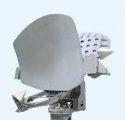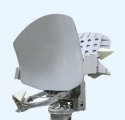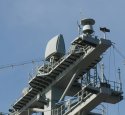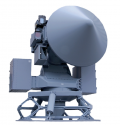This is absolutely meaningless as a response to my post that the rear quadrant of the 055 has a bar array which you OBVIOUSLY didn't know about before I posted it for you, and are now trying desperately to avoid having to admit that the smaller bar set ALSO has 360 degree coverage and therefore completely shatters your theory that it represents some kind of gun fire control because it allegedly only covers the gun's arcs. Which BTW is also unambiguously wrong, since the gun can easily cover >270 degrees.
I am still not sure if the back bar is an array as it does not have the right dimensions.
Were either of these photos supposed to blow up anyone's skirt somehow?
Yes. It shows you that assuming that an AshM targeting radar is long and thin is wrong.
Wow, you sound SO sure of yourself. And yet you are just SO utterly wrong LOL.
I want you to repeat to me what is written here:
Now can you man up, or can't you?
In one sentence two of your claims have been demonstrated to be unambiguously erroneous, namely that S-band cannot provide targeting data, and that SPS-67 does not provide fire control for the Burke's main gun.
SPS-67 is a C band radar, not an S-band. Furthermore, SPS-67 continually rotates, contradicting what you just said here...
These are totally irrelevant examples, since the current iteration of the AMDR X-band is as a rotating radar rather than a fixed 4-panel array like the 055 and the other examples I mentioned, as is the Plank Shave radar for the Sterguschy corvette. The reason these rotating radars are NOT used for gun fire control is because they are just search radars and do not stop rotating unless they want to risk not detecting a target in another quadrant. Radars like SPS-67 and SPQ-9 are primarily gun fire control radars and not mainly search radars.
Bingo, and you should know, that the way SPY-1D works is that it rotates the beams across all four faces.
SPS-67 *rotates*.
SPQ-9 doesn't. It turns side wards so one array faces port, and the other array faces starboard. Most gunnery is shot on the side, assuming for example, the target is headed to the side of the ship. This way, both sides of the ship are simultaneously being covered.
As a matter of fact, SAMPSON also rotates.
And yet the Puma looks absolutely nothing like the bars on top of the 055. The fact that the Poliment can be used only for air defense is probably more a function of its primitivity rather than some personal preference for multiple extraneous radars on a small corvette-sized ship especially when we have so many examples of other ship classes consolidating gun fire control into the ships' MFRs.
Actually it is a stationary phase array, much like the bars on top of the 055. It may turn towards the target.
Furthermore there are plenty of modern examples showing non consolidation --- French, Italian, and just about every US Navy ship except for the Burke which is also moving to this direction. The only purpose I can see of consolidation is to save money; it has no benefit, and all the disadvantages combat wise.
LOL I don't know anyone else who considers the Band Stand radar to be the "main X-band radar" on the ship, especially since its sole function is as an OTH ASCM targeting radar. The Sov doesn't have a "main" X-band radar like the 055 has a main X-band radar or the Sachsen has a main X-band radar.
Bandstand also works as an auxiliary search radar because that is what all radars with surface search ability do. Search needs to be a redundant task because when other radars are switched to doing something, something needs to take up the slack.
Nope. GFCS use many different bands, including S, C, X, and Ku, the former three of which I have already provided examples for (S: Daring, Burke; C: Burke, X: De Zeven Provincien, Sachsen, Iver Huitfeldt, etc.) so your statement that a random generic "GFCS" uses Ku-band is just preposterously wrong, regardless of what the PLAN happens to use on any particular ship.
Sigh. And you should know that all these examples have a somewhat flawed implementation.
For the ships using APAR, APAR is also used for missile guidance. Hence when the radar is lighting up for ESSMs, diverting radar resources to handle gunfire or CIWS support lessens the effectiveness of both. Same issue exists for the SAMPSON and the Darings, if you want to use it for gun control, you can't use it for search effectively. It does not exist for the French and Italian frigates, which uses the Thales STIR or the Selex fire control radar for gun control along with the Heraklex and Kronos search radars.
Burke and Daring uses EO to make up for the lack of precision the S band and rotating radars have. The fact that the Burke is moving to X-band phase arrays for gun fire control is telling.
Uhh, no. MFRs are a perfect way to describe X-band arrays, especially ones that are fixed 4-panel arrays, and even more especially ones on ships that don't have radars of other bands like S-band. They provide limited volume search, surface search, track, SAM midcourse and terminal guidance, and gun fire control. Newer ones can/will provide EW functions as well. This describes APAR to a T, for example. These functions are defining roles for any future X-band 3 or 4-panel array, like for example the future iteration of the Flight III X-band fixed arrays.
Geez. Position of the radar's ship tells you what its primary purpose are, MFR or not. Even an MFR has a primary purpose.
The highest position on the ship is reserved for the radar that is used to scan at the radar horizon for sea skimming threats. The higher the position, the farther the radar horizon stretches.
If you are using APAR for missile guidance or gun control, using it to scan the radar horizon for incoming sea skimming threats has its efficiency greatly reduced. For that purpose, its has to rely on the SMART-L radar for this purpose, but L-band does not do a good job discriminating and tracking small targets.
The fact that the Type 055's X-band is on top of the mast tower implies that it is the Type 364 replacement. The Type 364 is the secondary search radar you see on every PLAN ship, except for the Houbei which gets its smaller relative.
That X-band has its primary and most important function to search the radar horizon for incoming sea skimmer threats. Unlike the APAR equipped frigates, the Type 055 does not have a SMART-L or any other high mounted search radar to fall back on ---- the superstructure mounted Type 346s have a smaller radar horizon due to their reduced height placement. In fact, it surprised PLAN watchers why the Type 055 --- unlike speculated fan art --- did not have a high mounted L-band search radar. The high mounted radar needs to remain a search radar because this is the radar that is the first line of spotting to an incoming sea skimmer, the primary purpose for the Type 364.
The gunnery radar function has less of an importance and so it can be accorded a lower place in the ship. In fact it may be entirely possible both gunnery and antiship missile targeting can be integrated into one radar, which the Monolit does on the Gorshkov. But one thing for sure, is that the top part of the ship is far too important for a fire control function and should be reserved for a search radar primarily that works all the time, full time, as a vigilant search radar.



















